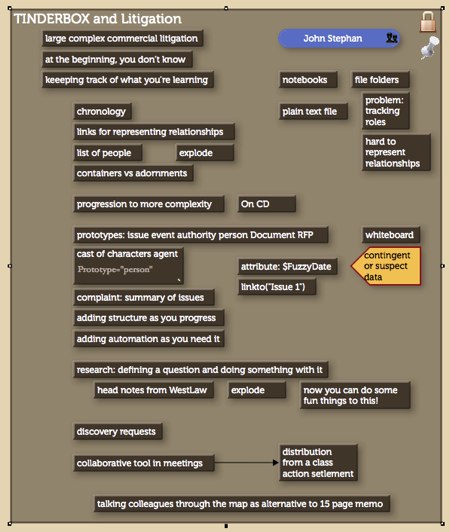Tinderbox Weekend: Tinderbox and Litigation
By the way, you can get the Tinderbox Weekend CD for just $35 from Eastgate. There’s a lot of new stuff, and plenty everything’s been brought up-to-date for Tinderbox 5.
At Tinderbox Weekend Boston, Massachusetts Assistant Attorney General John Stephan discussed Tinderbox and Litigation. One key theme, which recurred throughout the weekend, was the utility of the Tinderbox map for talking colleagues through an issue, an alternative to writing (and reading) a 15-page memo.
Here are some of my Tinderbox notes on John’s talk. Let’s give it a try. (If you've got a nice screen, go ahead an open the full-size image)
Litigation gets complex. Even simple cases become complicated: Tom Lowe later recalled a simple medical case that ramified through dozens of physicians, health care providers, and secondary injuries, while Steve Winnick mentioned a simple homicide appeal that soon became a tangle of forensic and eyewitness contradictions. At the beginning of a case you don’t know what you have; the key is to keep track of what you’re learning.
Some prototypes are bound to be useful: issues, events, authorities, people, documents, and rfp’s are bound to enter into any legal Tinderbox. The new “favorites” scheme, and Mac OS X’s handy (but little-known) stationery facility, makes preloading these standards easy.
Another recurrent theme was the utility of the Explode tool. Grab some head notes from Westlaw, mark the seams, explode, and you’ve got a terrific starting point for research, for team coordination, and for argument building.
Finally, the one common theme I actually flagged during the talk (the yellow tag note) is the problems posed by contingent, uncertain, or suspect data. We don’t have terrific tools for representing lies and uncertainties, but a spatial hypertext tools with Tinderbox’s rich visual vocabulary gives you lots of choices for jotting things down.
